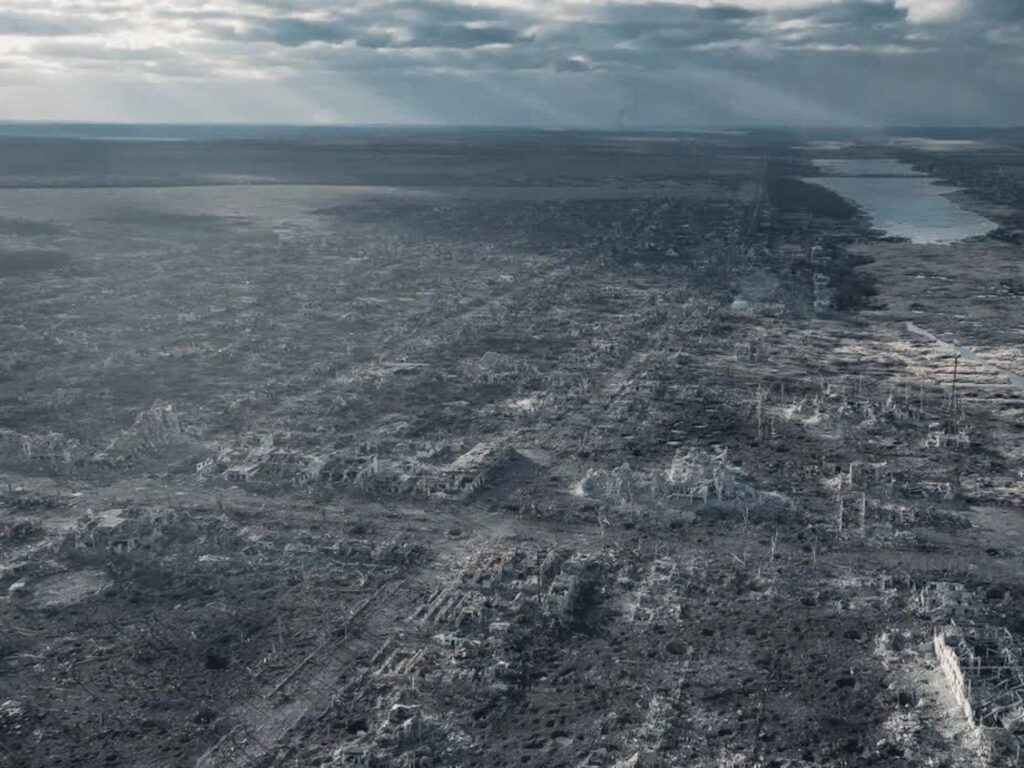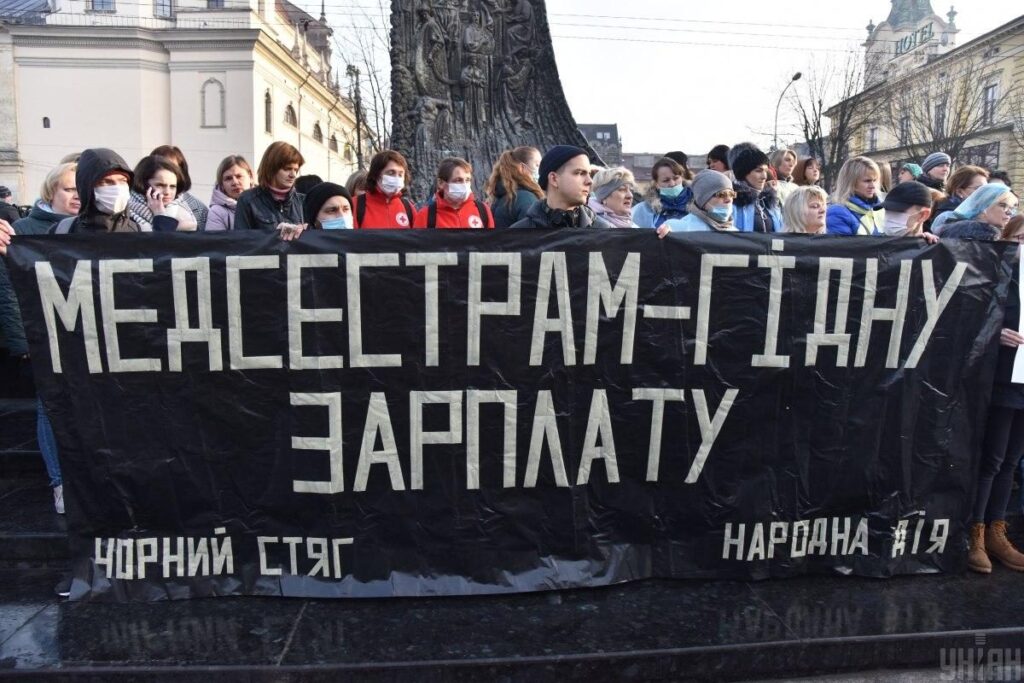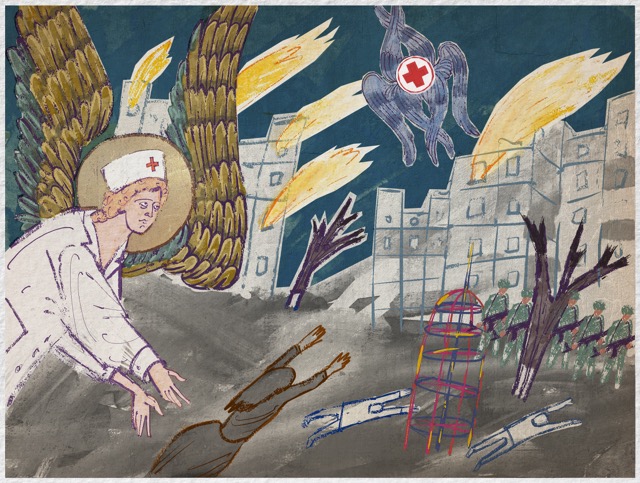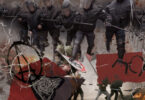The Romanian version of the article can be read here.
I mostly will be talking about things related to care and care infrastructure, which is a generic term used for very common things we encounter in our everyday life. It’s about caring for those who are ill, wounded, and have disabilities. It’s about child care. It’s about caring for elderly people. So all these things which make the society, life in society possible and sustainable. My research focus in these care sectors is both the infrastructure and the labor of those who participate in it, and how the Russian invasion affects the situation there.
I will be talking briefly about several topics. When we speak about everyday life and violence, of course, in the context of war, the first thing which comes to our mind is direct violence, destruction and suffering. But feminist scholars often point to a more invisible part of the reality, which is structural violence, often caused by different policies, for example, those which fit into the umbrella of neoliberal policies, austerity policies, welfare cuts and so on. So, things which basically reduce our access to care infrastructure, to public kindergarten, schools, hospitals, elderly residential care and care for people with disabilities.
Structural violence is also part of the Ukrainian story, especially after 2014, when the government changed and the economic crisis started after Russia annexed Crimea and war in Eastern Ukraine began. So these austerity policies were very much present in Ukraine, and that’s what I was researching previously, but of course the full scale war added another huge dimension to that, limiting access of many people to care infrastructure.
First I will briefly speak about destruction, which is obviously part of the war picture.
So to sum up, 12 percent of Ukrainian educational infrastructure is either damaged or destroyed. You should keep in mind two things: that this is a very approximate figure which I tried to calculate, using the available data, and that part of this infrastructure is also being rebuilt and repaired in the process (obviously some parts are not). Respectively, the numbers rather reflect how much impact was made, not the current state of this infrastructure.
At the same time, approximately 14 percent of healthcare infrastructure was damaged or destroyed. And as you know, from the events in Ukraine, but also earlier in, for example, in Syria, the Russian army often practices deliberate attacks on health care workers, ambulances and facilities.
Additionally, there are the so-called “double strikes” when the rocket hits something, like a civilian building, and when the rescuers and medical workers rush in, another rocket arrives. These tactics of the Russian army are the context in which approximately 200 healthcare workers were killed in Ukraine. And this figure does not include combat medics, who participate in the army.
Just one more thing about destruction: this is a very famous picture. It’s from Marinka. It was a town in Donetsk region, close to Donetsk itself, which until 2022 was under Ukrainian control.

There was a very heavy fighting after the beginning of the invasion, and basically the town, which had approximately 10 thousands inhabitants – at this point the town does not exist anymore. This was the first picture like that, but later there were, unfortunately, many more from other towns. This is obviously the picture of a setting where everyday life is basically impossible, it is about the total destruction of care infrastructure and infrastructure of social reproduction of any kind. But of course you should also keep in mind that Ukraine is big and different territories are impacted very unequally.
Yesterday or the day before yesterday somebody asked me whether my kids go to school. Yes, they do. They do it on a regular basis every day because I am in Kyiv, which is heavily protected and luckily far from the front line. But there are very different regions and the impact of the ongoing war is very different on everyday life there.
Everyday life must go on in a way, where it’s still possible – that is how human societies work. For life to go on under radically different circumstances, there must be different adaptations, on different levels. Further I will speak briefly about them.
For example, in the case of education in many territories in Ukraine, schools and kindergartens operate on a daily basis, offline. To be able to function, they must have a shelter, so in case there is a threat of air attack, kids go underground. At the same time, there are regions, mostly in eastern and southern Ukraine, partially northern Ukraine, where this is not possible because the front line is too close. The most famous example is Kharkiv city because it’s huge.
It was the second biggest city in Ukraine after Donetsk became controlled by separatists. And Kharkiv is very close to the Russian border, to the Russian army, basically, meaning it is within the range of artillery, which is close to impossible to intercept by the air defence systems. In this context, from the very beginning, the authorities decided that schools can theoretically operate, but only if they have a proper air raid shelter, not just a basement where kids can hide.
And of course, none of the schools or kindergartens had this proper shelter, so they were closed in this huge city, which still has a population over a million. Looking for at least some solutions, at some point the local authorities decided to start school in the metro. You should not imagine that this is like the platform where trains are going and kids are trying to learn something. The metro infrastructure has different technical rooms, which are also underground. And in these rooms they try to continue teaching. I think that maybe a bit more than 1,000 kids attend it – this is not a lot for such a big city, of course, rather it’s literally a drop in the ocean.
Many children are on distant learning, like online schooling. At some point, when it became obvious that the war won’t end soon, the city also started to build the whole school underground, and it’s operating now, so there is also an underground school in Kharkiv, and some other big cities are in the process of building similar underground schools.
They are not big, not enough, but these are examples of how the educational system tries to adapt on the institutional level. So local authorities try to somehow accommodate the needs for education.
It’s a bit different with health care because you cannot do it online. Only a very tiny portion of healthcare – telemedicine – can be done online, like distant healthcare, right? Naturally, hospitals try to accommodate people in shelters if there is a threat of attack, but you can imagine that in many cases it’s not possible because people are going through some complex procedures, they are on ventilators or other medical equipment. In such circumstances medical workers bring them to the corridors or other safer zones, if possible, they cover the windows with sandbags, and so on.
And yet another story is about elderly care and people with disabilities: authorities evacuated some residential care facilities, others use the same procedures as in hospitals – shelters, safer zones, sandbags. With visiting care these are the risks and work overload which are taken by social workers to attend those who need their support..
Obviously, the existing care infrastructure often fails to fulfil its functions. And it has been failing always, just to a different (sometimes – very different) degree. In any society you always have these care gaps, an unaddressed part of the care work, which must be done anyway. It cannot be done inside the existing care infrastructure for various reasons – because life is unpredictable, or because those institutions are going through budget cuts and they are shortening available places or hours or whatever, or because they are destroyed during military hostilities. In any case – there are always the care gaps, which in Ukraine, as in many other societies, are managed through informal networks.
These informal networks of care support are very gendered: we have grandmothers, we have sisters, who provide different support, or we have neighbors who can step in in some extreme cases. Of course, we have husbands and wives who can theoretically and practically share the care obligations. But when you have this huge population shift, abrupt and forced, like displacement, refuge abroad, these networks, which people have preestablished, they’re broken. So, for example, women flee from the war without their mother or grandmother. The refugees find themselves in unfamiliar settings, where they don’t know how local infrastructure works, or there are no places for them in the kindergartens, for example, in Germany, or in Moldova, or in Poland.
In this context, for me, it was also interesting to observe how Ukrainian refugees, most of whom were women with kids, are trying to rebuild this network, usually between themselves, like to help each other, to manage some parts of the care job, which cannot be skipped. These processes and connections behind them are very close to me because it is also my experience.
And yet another question is in the context of territories which are extremely endangered, and still there are people who need care. If you’re speaking about schools, okay, they can do online schooling. But it is very different if you’re speaking, for example, about elderly people who are staying behind, very often they are the least mobile population of all: they don’t want to leave, they have limited possibilities to leave. So very often these are elderly people who are staying behind, need care, because they don’t have any family, or their family moved, looking for safety. Here the adaptation to the realities of war often happens at the expense of the remaining social workers, who continue caring for those people – for a very low wage, with a lot of physical risks involved.
There is a colleague of mine, Natalia Lomonosova, who has been doing research on social workers for years in Ukraine, including during the war. And when we discuss it, we kind of come to this concept “prisoners of love” which is often about these extremely feminized care jobs. It is about exploitation of love and feeling of obligation, while care is perceived as a natural obligation of women, it is kind of imposed on them, and these are mostly women who are working in these sectors.
In Ukraine the most updated data shows that twenty five percent of working age women in Ukraine work in care, meaning health care and education mostly.
Even in the territories which are very close to the front line, few social workers remain because they cannot leave people behind, those people are dependent on them. This is sometimes the same for healthcare workers. Еhey understand that if they quit, nobody would be there to attend to the people in need, and so they are staying. For this reason the question of labor in general is always very important, but it is explicitly important here, in the context of war.
The last aspect I wanted to talk about is care labor in the context of structural violence. And as I’m being leftist, I strongly believe that the question of labor, and the question of care labor must be politicized. The example which has been there for some years is the example of Ukrainian nurses.
Since 2019 in Ukraine we have the independent movement of nurses who work in healthcare. As in many countries, this movement started during COVID, when the work of nurses was highlighted.
Here you see some pre invasion protests the nurses had.
So in the first picture it’s ”Give decent wages to nurses”.

And on the second picture it’s written “Even coronavirus would die having such a job”.

And the movement itself was relatively successful. They managed to push the government to double the wage of nurses: at the end of 2021 the government passed a separate bill. So in 2022 the nurses were supposed to get a double wage, but then the invasion started, and everything got complicated. Currently some of the nurses receive these higher wages, some of them don’t. Now we are also working with them, trying to raise the question of workload. Because in Ukraine, with the medical reform (a very problematic medical reform), they totally removed the regulation of the workload for nurses, and
now it is almost totally unregulated. And it means that these adaptations and these budget cuts, which often happens during any crisis, and especially crises like this – these are managed at their expense because the wage is low, people quit, and those who remain, they have to manage somehow.
I will briefly go to the conclusion, which is why I was bringing the question of labor. This is an example when the issue of care is politicized, which is very rare in Ukraine, and I think in many countries of the region we don’t see much politicization.
For me as a feminist, it’s always also a feminist issue.
But, for example, we have these big mainstream feminist groups on Facebook. And when you post something about working conditions of nurses, or about their wages, or about wages in kindergartens, there will always be some people who will ask, but what does it have to do with feminism? Sometimes you don’t have words to explain, but yeah, we are trying.
Politicizing these questions is extremely important for everyday life in Ukraine. It is important for any other country, of course, but especially for Ukraine which is undergoing a huge shift. Society is very destabilized now. We have, unprecedented demographic shift, with millions of people who left the country, part of them would obviously never return back, with the increasing portion of elderly people in the population, with an increasing number of those who are wounded and those who will have permanent disability and who would need sometimes quite intensive care for the rest of their life.
The issues of care become extremely important in this context. Of course you need to include them into discussion about any prospects for the future. But currently it is really hard to talk about any “post-war” prospects or “post-war” reconstruction, because the war does on without clear end on the horizon. .Without securing peace of any kind, without making it sustainable, without removing the threat of further attack the society’s demographic won’t stabilize, and society in general will not stabilize either.
When you have the ongoing threat across the border it is hard to talk about sustainable society and development. But this talk needs to be done.
In relation to care which, as I said, becomes vitaly important in the context of war and demographic changes, official discourse of reconstruction is astonishing. There are two main official documents on post war reconstruction: National Recovery Plan and Ukraine Facility Plan. Many of the points there are problematic, but absence of the care issues is even more telling: the issues of care are almost totally absent. This silence is especially surprising (or predictable) in relation to the question of elderly care, which would be a huge challenge now, while the infrastructure of elderly care is in the worst condition, compared to other care infrastructure.
The Facility Plan is a document which says that in order to join the EU and to get EU funding now, Ukraine has to fulfill some conditions, undergo some reforms. In other words, this document is financially binding. In this text, for example, elderly care is mentioned once, and only in a way that we should deinstitutionalize elderly care (as well as care for people with disabilities and children deprived of parental care), because that is also the requirement of the EU. Deinstitualization itself is a great idea in itself: it’s very important for human rights, for avoiding abuses in institutions, for better care. The problem is – we don’t have infrastructure for this deinstitutionalization, we don’t have the small community centers to accommodate all the people who need this care. And, furthermore, the National Recovery Plan does not mention elderly care needs at all.
So, the issues of care infrastructure and care labor are almost totally absent on the official level of discussion. They’re barely present on the international level, including, for example, in the European Parliament, and hardly voiced by European parliamentary leftists – for various reasons. Part of that story is because, unfortunately, and as you may know, many European leftists kind of totally turned their sight away from Ukrainian reality. They don’t want Ukraine to get weapons, so they don’t want to engage with people on the ground, with Ukrainian trade unions or Ukrainian leftists, because we are too “nationalistic”, too “militaristic” for them. This also means that they do not intervene in these debates about post-war reconstruction. With the exception of some Nordic leftists, European parliamentary leftists abstain from voicing the important issues of labor, inequality, needs, we are trying to voice.
In the end, international debates on Ukraine’s post-war reconstruction are mostly done by liberals, neoliberals, conservatives and so on. This is true both on a national and international level. And this is the context, in which Ukrainian labor and progressive forces are trying to voice the urgent issues of labor and care, the sustainable visions of future developments, however vague the Ukrainian future may look now.
This article is based on a presentation by Oxana Dutchak during the Public Discussion: Sustaining life during the war and leftist perspectives on Peace, which took place in Chișinău, on February 26, 2025.
The public discussion was organized as part of the non-conference Chișinău Leftist Media Convergence: Against Fragmentation Amidst Crises and War: Building Common Leftist Discourses in Central and Eastern Europe and the Balkans, which is taking place from February 24–27. The event is organized by PLATZFORMA and the Eastern European Left Media Outlet (ELMO), with financial support from the Rosa Luxemburg Stiftung, e. v.,zastoupení v České republice.
Oksana Dutchak is a sociologist and social anthropologist, co-editor of Commons/Spilne online journal, based in Kyiv.
Background image: Life during the war by Victor Ciobanu









